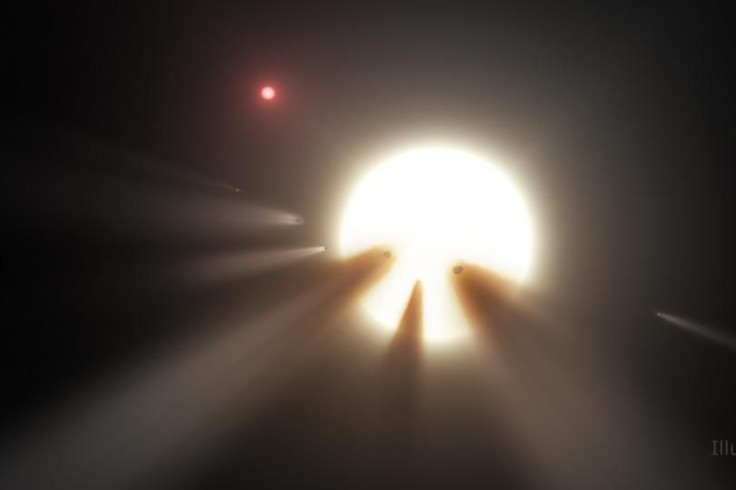‘Alien Megastructure’ Star Mystery Deepens After Fresh Kepler Data Confirms Erratic Dimming

The case of Tabby’s star keeps getting curiouser and curiouser. The star — formally known by its somewhat clunky name KIC 8462852 — has been a source of endless intrigue for astronomers since September, when its bizarre behavior triggered speculations over the existence of an alien civilization around it.
The WTF (Where’s the Flux) star is now back in the news, and it's more mysterious than ever.
Before we delve into the latest findings, released online through the preprint server arXiv, here is a quick lowdown of the story so far:
Last fall, a team of scientists led by Tabetha Boyajian from Yale University, who lends the object its informal name, the “Tabby’s star,” reported that the star was not behaving as it should. Based on observations conducted using NASA's Kepler Space Telescope between 2009 and 2013, the team witnessed two unusual incidents, in 2011 and 2013, when the star's light dimmed in dramatic, never-before-seen ways.
This dimming indicated that something had passed in front of the star — located between the constellations, Cygnus and Lyra. At the time, a swarm of comets was proposed as the most likely explanation.
However, this is not when Tabby’s star captured the public’s imagination. That happened a month later, in October, when Jason Wright, an astronomer from Penn State University, put forth the idea that the swarm of objects around the star is “something you would expect an alien civilization to build.”
In other words, he suggested that the swarm may be an “alien megastructure,” or a giant Dyson sphere, built by a technologically advanced species to harness the star’s energy.
Unfortunately, two subsequent independent searches, especially tailored to detect alien radio signals and laser pulses, drew a blank, and, earlier this year, a study based on analysis of photographic plates of the sky dating back to the late 19th century argued that even the comet swarm idea, which was the best of the remaining proposals, cannot explain the star’s erratic dimming — although the study’s findings were widely disputed.
In the new paper — which is yet to be peer-reviewed — Caltech astronomer Ben Montet and Joshua Simon of the Carnegie Institute detail their analysis of photometric data of the star gathered by the Kepler space telescope.
Their findings — the star was definitely dimming at a rate that defies explanation over the four years Kepler monitored it. For instance, in the first 1,000 days of Kepler’s observations, the star’s luminosity dipped by roughly 3.4 percent per year, before dropping dramatically by 2.5 percent in a span of just 200 days — something that suggests that the long-term dimming hypothesis may very well be true.
“We note these results are apparent in data from each individual detector, not just the combined light curve, suggesting that the decline in flux is an astrophysical effect rather than an instrumental one,” the researchers wrote in the paper. “We offer no definitive explanation that could explain the observed light curve in this work. The effect could be stellar in nature, although there are no known mechanisms that would cause a main-sequence F star to dim in brightness by 2.5 percent over a few months. The effect could also be caused by a passing dust cloud in orbit around KIC 8462852.”
Although the study seems to rule out all the possible explanations that have been put forward so far — a swarm of comets, planetary fragments, or a distorted star — it does not mean the dimming is caused by an alien megastructure. It just means we still don’t have an explanation for what is causing the star’s light pattern to dip erratically.
“The new paper states, and I agree, that we don’t have any really good models for this sort of behavior,” Wright told Gizmodo. “That’s exciting!”
Those looking for a satisfactory explanation would now pin their hopes on a team of researchers led by Boyajian, which recently successfully crowdfunded a campaign to secure observation time at the Las Cumbres Observatory Global Telescope Network — a privately run network of telescopes set up around the globe to ensure continuous monitoring of an object.
For now, though, “the most mysterious star in our galaxy” continues to live up to its fame.
© Copyright IBTimes 2025. All rights reserved.






















